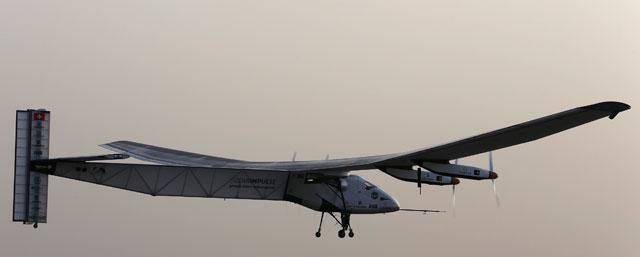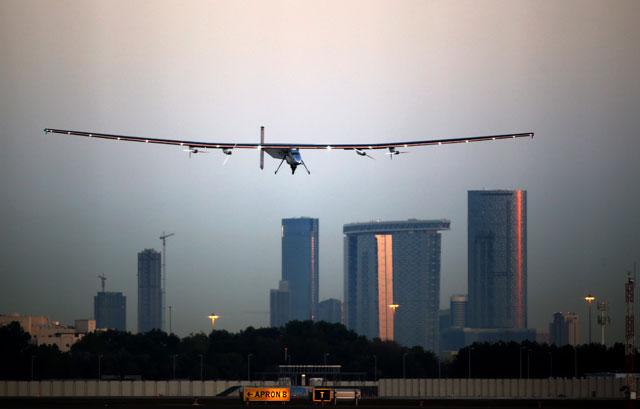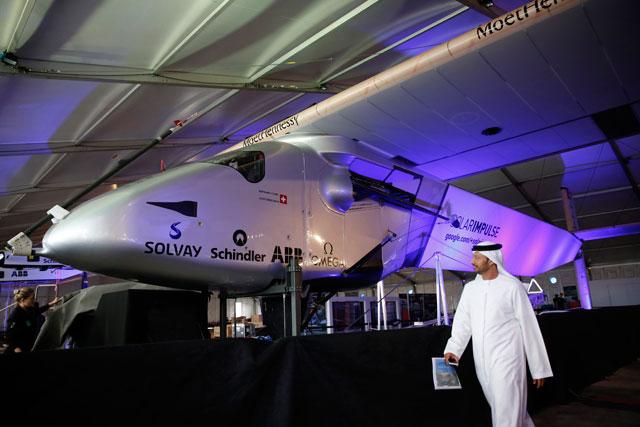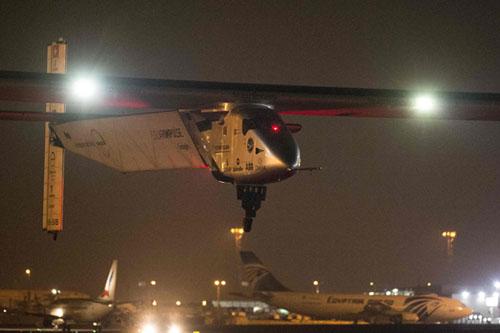You are here
Solar plane completes 1st leg of epic round-the-world bid
By AFP - Mar 09,2015 - Last updated at Mar 09,2015

MUSCAT — Solar Impulse 2 landed Monday in Oman, completing the initial leg of its epic bid to become the first solar-powered plane to fly around the world, testing its pilots to the limit.
The aircraft touched down in Muscat after nightfall, 13 hours and two minutes after taking off from Abu Dhabi.
Pilot Andre Borschberg, who was at the controls on the 400-kilometre trip, smiled and waved to his team after landing.
"The adventure has started," Solar Impulse Chairman Bertrand Piccard had said just after Borschberg took off in the early morning from Abu Dhabi's Al Bateen Airport on the historic circumnavigation aimed at promoting green energy.
The takeoff by Solar Impulse 2, which had originally been scheduled for Saturday but was delayed because of high winds, capped 13 years of research and testing by Swiss pilots Borschberg and Piccard.
Live video streaming on the www.solarimpulse.com website monitoring the unique aircraft's progress showed the pilot, wearing an orange jumpsuit, breathing using an oxygen mask.
"From Mission Control Center in #Monaco the engineers are helping me to perform Oxygen Mask tests from #SolarImpulse," he tweeted.
Borschberg earlier called his wife from on board, according to the live feed.
Shortly before takeoff, the 63-year-old pilot tweeted that the "challenge to come is real for me & the airplane".
The wingspan of the one-seater known as the Si2 is slightly bigger than that of a jumbo jet, but its weight is around that of a family car.
From Muscat, it will make 12 stops on an epic journey spread over five months, with a total flight time of around 25 days.
On Tuesday, it is expected to cross the Arabian Sea to Ahmedabad in India before later legs to Myanmar, China, Hawaii and New York.
Landings are also earmarked for the midwestern United States and either southern Europe or North Africa, depending on the weather conditions.
The longest single leg will see a lone pilot fly non-stop for five days and nights across the Pacific Ocean between Nanjing, China and Hawaii, a distance of 8,500 kilometres.
Cockpit like home
Borschberg and Piccard will alternate stints flying the plane, which can hold only one person, with the aircraft able to fly on autopilot during rest breaks.
"You have to make the cockpit like your own house... you go to the toilet, you wash yourself with wet wipes, you eat, you drink, you recline the seat to have some rest, you turn on the autopilot," Piccard told reporters.
Both pilots have undergone intensive training in preparation for the trip, including in yoga and self-hypnosis, allowing them to sleep for periods as short as 20 minutes but still awake feeling refreshed.
All this will happen without burning a drop of fuel.
While in the air, the pilots will be linked to a control centre in Monaco where 65 weathermen, air traffic controllers and engineers will be stationed. A team of 65 ground staff will travel with the two pilots.
Should a problem occur while a pilot is asleep, the support staff can wake him.
"We want to share our vision of a clean future," Piccard said of the mission, which was ridiculed by the aviation industry when it was first unveiled.
But the 57-year-old, who hails from a family of scientist-adventurers and in 1999 became the first person to circumnavigate the globe in a hot air balloon, clung to his belief that clean technology and renewable energy "can achieve the impossible".
The plane is powered by more than 17,000 solar cells built into wings that, at 72 metres, are longer than on a Boeing 747 and approaching those of an Airbus A380 superjumbo.
Thanks to an innovative design, the lightweight carbon fibre aircraft weighs only 2.3 tonnes, about the same as a family 4X4 and less than 1 per cent of the weight of the A380.
The Si2 is the first solar-powered aircraft able to stay aloft for several days and nights.
The propeller-driven craft has four 17.5 horsepower electric motors with rechargeable lithium batteries.
It will travel at 50-100 kilometres per hour, with the slower speeds at night to prevent the batteries from draining too quickly.
"This airplane is conceived to stay airborne days and nights in a row, maybe a week, so we hope that we make these very long flights because this is the demonstration of the vision of flying solar power with no fuel forever," said Piccard.
Related Articles
Just after dawn on Monday, Swiss pioneers will embark on the first round-the-world trip ever attempted with a solar-powered plane.
A plane with the top speed of a homing pigeon is set to embark on a landmark round-the-world flight powered only by the sun's energy, organisers said Tuesday.
CAIRO — The first solar-powered plane to circle the world took off from Cairo on Sunday for Abu Dhabi, in the final leg of its journey.Swiss
















